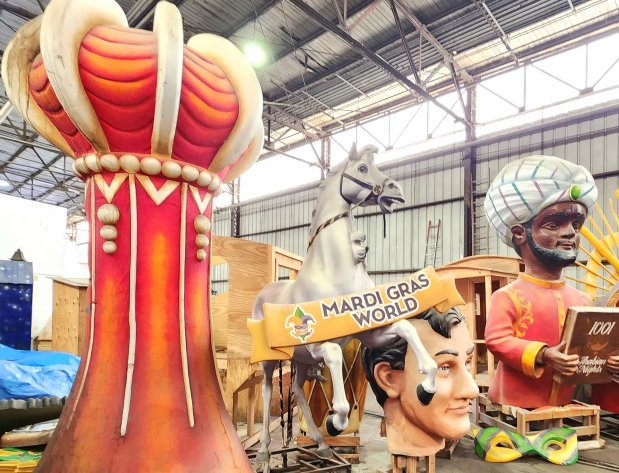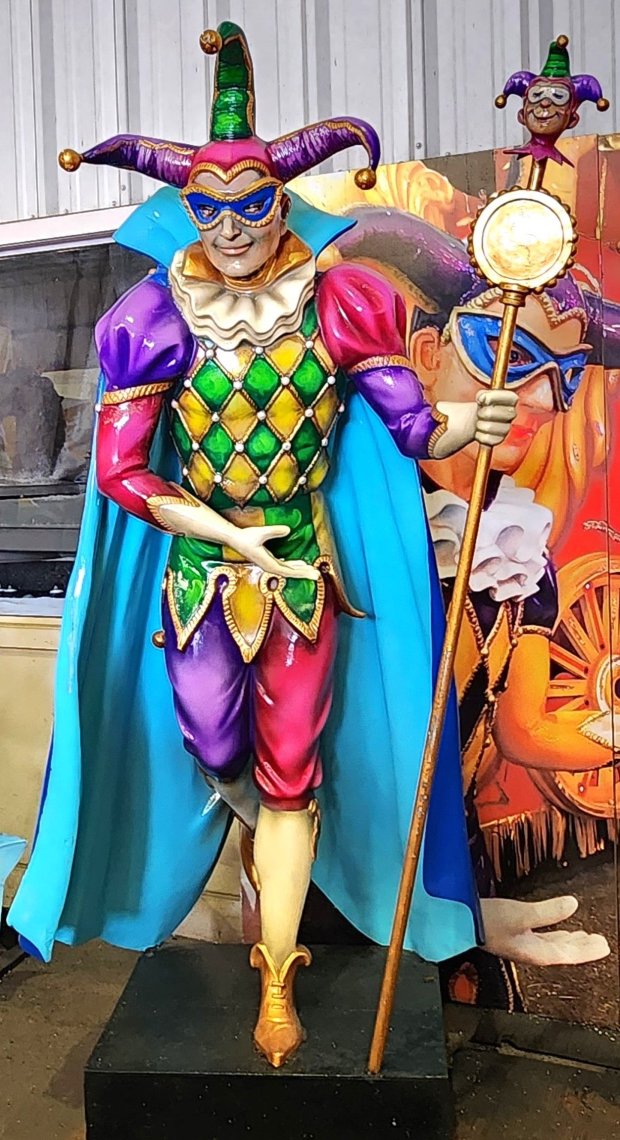No other place celebrates Mardi Gras like New Orleans. More than a million people descend on the Big Easy every year for the bacchanalia, partying in the streets as the best parades on the planet pass by. The party actually starts weeks before Fat Tuesday on Twelfth Night, Jan. 6, and this year it will end Feb. 18.
However, the biggest day will be Feb. 13, the day before Lent begins.
There’s one place in New Orleans where every day is Mardi Gras. Blaine Kern’s Mardi Gras World is both a working factory and a museum. Open year-round, the 300,000-square-foot warehouse offers a behind-the-scenes look at how the famous floats are made and contains even more weird and wonderful characters than Bourbon Street.
A court jester made for a previous float stands sentry at Blaine Kern’s Mardi Gras World in New Orleans. If you head to the Big Easy for one of the parades, you might just see him show up on a new entry.
We took a tour last summer, and were thrilled to get up close and personal with the best floats in the world.
Every parade needs brightly decorated vehicles and even though there are few Mardi Gras calvalcades here in the Midwest, we do have floats, most of which are built by locals. It’s something that’s much harder to do than it looks, which is why we tend to get excited even if someone adds an apron of tinsel to a flatbed trailer.
The Macy’s Thanksgiving Day parade in New York is a fine example of what you can do with more expertise and a giant budget. Their floats and balloons are always a thrill, even if most of us only get to marvel at them on TV.
But Mardi Gras is in a class of its own.
In New Orleans there are floats for 18 parades each Mardi Gras season, but you can also see some of their artists’ work around the country. They’re the ones behind the iconic characters that adorn M&M’s World in New York and Las Vegas as well as the infamous Chick-fil-A cows you sometimes see climbing bill boards along expressways.

A court jester made for a previous float stands sentry at Blaine Kern’s Mardi Gras World in New Orleans. If you head to the Big Easy for one of the parades, you might just see him show up on a new entry.
New Orleans Mardi Gras floats are created by various “krewes,” each of which set their own theme and design. Some go for the historical or mythological, others prefer satire. The floats are usually made of wood and papier-mâché, but today you might also see characters fashioned from Styrofoam. We were told it’s much easier to replace any part that breaks off using this material than say fiber glass, where you’d have to start over.
The eclectic props are made not by carving one piece of Styrofoam as you might expect, but by gluing layers of them together with an insulation foam called Great Stuff. Once the glue has dried, the sculptors carve them out with kitchen knives, hot knives and horse brushes called curry combs. Sandpaper is used to smooth the edges.
Even large props are pretty light, which makes assembly easier. However, to prevent them from blowing over, they are balanced with a wooden arm in the center.
As technology advances (Blaine Kern built his first float with his father in 1932), the factory also uses newer methods. Pixie is a robot that can mill a sculpture up to 60 feet long. As well as handling Styrofoam, she can also carve through stone, wood, clay and metal if needed. She’s named for an employee who worked at Kern Studios for 47 years.
It’s the attention to detail that makes the decorated floats so wonderful. Whether close-up in the factory or obscured by hundreds of people at the side of the road, they need to stand out. They’re absolutely huge, pulled by tractors along the wider city streets. But they’re practical as well as beautiful.
Our guide pointed out dozens of hooks inside the floats that are used to hang the beads that are thrown out to the excited crowds. Since those gliding down the roads are allowed to drink alcohol, lavatories are also tucked away behind the lavish décor.

Blaine Kern’s Mardi Gras World in New Orleans, a giant warehouse of things built for Mardi Gras parades, is part working factory and part museum that offers a little insight into how the float decorations are made.
Parties are as big a part of Mardi Gras as the parade, with dozens taking place each year. Mardi Gras World even opens up its site for private parties, which is very handy if you’re looking to have a float or two drive through your celebration.
Walking around what is arguably the most fun museum anywhere, it’s like you’re in a giant toy shop crossed with the set of a horror movie. Superman with his arms outstretched guards a huge treasure chest full of jewels. Jesters look as if they’re about to be run over by steam trains while Cleopatra rides atop a giant ship plowing through waves. There are religious figures and musicians, animals and birds, ax-wielding Vikings and famous faces like Marilyn Monroe.
It makes me think might make for a fun night in a museum — but don’t leave your courage at the door if you hope to last till dawn.
Hilary Decent is a freelance journalist who moved to Naperville from England in 2007. hilarydecent@gmail.com




